Visualizing the Academic Discipline of Knowledge Management
Abstract
1. Introduction
- (1)
- What are the characteristics and growth trends of KM publications?
- (2)
- What are the international collaborating countries that have the most KM research?
- (3)
- Where are the active contributors located?
- (4)
- What are the characteristics of the authorship distribution?
- (5)
- What are the core KM disciplines and journals?
- (6)
- What are the core KM research keywords?
- (7)
- What is the intellectual structure of KM research?
- (8)
- What are the emerging trends in KM research?
2. Related Work
3. Materials and Methods
4. Results
4.1. Distribution by Publication Year
4.2. Distribution and International Collaboration among Countries (Territories)
4.3. Institution Distribution and Collaboration
4.4. Authorship Distribution
4.5. Distribution of Subject Categories
4.6. Journal Distribution
4.7. Keyword Co-Word Network
4.8. Intellectual Structure of Knowledge Management
4.9. Emerging Trends
5. Discussion and Conclusions
5.1. Discussion
5.2. Implications for Academics and Practitioners
5.3. Limitations and Direction for Future Research
Acknowledgments
Author Contributions
Conflicts of Interest
References
- Spender, J.C. Making knowledge the basis of a dynamic theory of the firm. Strateg. Manag. J. 1996, 17, 45–62. [Google Scholar] [CrossRef]
- Nissen, M.E. Redesigning reengineering through measurement-driven inference. MIS Q. 1998, 22, 509–534. [Google Scholar] [CrossRef]
- Pirró, G.; Mastroianni, C.; Talia, D. A framework for distributed knowledge management: Design and implementation. Future Gener. Comput. Syst. 2010, 26, 38–49. [Google Scholar] [CrossRef]
- Wiig, K.M. Knowledge management: Where did It Come From and Where Will It Go? Expert Syst. Appl. 1997, 13, 1–14. [Google Scholar] [CrossRef]
- Bhatt, G.D. Organizing knowledge in the knowledge development cycle. J. Knowl. Manag. 2004, 1, 15–26. [Google Scholar] [CrossRef]
- Wong, K.Y.; Aspinwall, E. An empirical study of the important factors for knowledge management adoption in the SME sector. J. Knowl. Manag. 2005, 9, 64–82. [Google Scholar] [CrossRef]
- Centobelli, P.; Cerchione, R.; Esposito, E. Knowledge management systems: The hallmark of SMEs. Knowl. Manag. Res. Pract. 2017, 15, 294–304. [Google Scholar] [CrossRef]
- Money, W.; Turner, A. Knowledge Management Information Technology User Acceptance: Assessing the Applicability of the Technology Acceptance Model. In Knowledge Management in Modern Organizations; Jennex, M., Ed.; Idea Group Inc.: Calgary, AB, USA, 2007; pp. 233–254. [Google Scholar]
- Nikabadi, S.M. Framework for knowledge management processes in supply chain. Ira. J. Inf.process. Manag. 2014, 28, 611–642. [Google Scholar]
- Alavi, M.; Leidner, D.E. Knowledge management and knowledge management systems: Conceptual foundations and research issues. MIS Q. 2001, 25, 107–136. [Google Scholar] [CrossRef]
- Gu, Y. Global knowledge management research: A bibliometric analysis. Scientometrics 2004, 61, 171–190. [Google Scholar] [CrossRef]
- Henry, N. Bureaucracy, technology, and knowledge management. Public Adm. Rev. 1975, 35, 572–578. [Google Scholar] [CrossRef]
- Barclay, B.R.O.; Murray, P.C. What is knowledge management? Knowledge Praxis, 11 May 2009. Available online: http://www.mediaaccess.com/whatis.html (accessed on 5 May 2017).
- Esposito, C.; Ficco, M.; Palmieri, F.; Castiglione, A. A knowledge-based platform for big data analytics based on publish/subscribe services and stream processing. Knowl.-Based Syst. 2015, 79, 3–17. [Google Scholar] [CrossRef]
- Durst, S.; Edvardsson, I.R. Knowledge management in SMEs: A literature review. J. Knowl. Manag. 2012, 16, 879–903. [Google Scholar] [CrossRef]
- Cerchione, R.; Esposito, E.; Spadaro, M.R. A literature review on knowledge management in SMEs. Knowl. Manag. Res. Pract. 2016, 14, 169–177. [Google Scholar] [CrossRef]
- Cerchione, R.; Esposito, E. A systematic review of supply chain knowledge management research: State of the art and research opportunities. Int. J. Prod. Econ. 2016, 182, 276–292. [Google Scholar] [CrossRef]
- Inkinen, H. Review of empirical research on knowledge management practices and firm performance. J. Knowl. Manag. 2016, 20, 230–257. [Google Scholar] [CrossRef]
- Centobelli, P.; Cerchione, R.; Esposito, E. Knowledge management in startups: Systematic literature review and future research agenda. Sustainability 2017, 9, 361. [Google Scholar] [CrossRef]
- Nordenflycht, A.V. What is a professional service firm? Toward a theory and taxonomy of knowledge-intensive firms. Acad. Manag. Rev. 2010, 35, 155–174. [Google Scholar] [CrossRef]
- Leiponen, A.; Helfat, C.E. Innovation objectives, knowledge sources, and the benefits of breadth. Strateg. Manag. J. 2010, 31, 224–236. [Google Scholar] [CrossRef]
- Ensign, P.C.; Hébert, L. How reputation affects knowledge sharing among colleagues. MIT Sloan Manag. Rev. 2010, 51, 79–81. [Google Scholar]
- Styhre, A. Understanding Knowledge Management: Critical and Post-Modern Perspectives; Business School Press: Copenhagen, Denmark, 2003. [Google Scholar]
- Butler, F.A.; Stevens, R. Standardized assessment of the content knowledge of English language learners k–12: Current trends and old dilemmas. Lang. Test. 2001, 18, 409–427. [Google Scholar]
- Lee, M.R.; Chen, T.T. Visualizing Trends in Knowledge Management. Knowledge Science, Engineering and Management; Springer: Berlin, Germany, 2007; pp. 362–371. [Google Scholar]
- Lee, M.R.; Chen, T.T. Revealing research themes and trends in knowledge management: From 1995 to 2010. Knowl.-Based Syst. 2012, 28, 47–58. [Google Scholar] [CrossRef]
- Li, C.; Guo, F.; Zhi, L.; Han, Z.; Liu, F. Knowledge management research status in china from 2006 to 2010: Based on analysis of the degree theses. Scientometrics 2013, 94, 95–111. [Google Scholar] [CrossRef]
- Dwivedi, Y.K.; Venkitachalam, K.; Sharif, A.M.; Al-Karaghouli, W.; Weerakkody, V. Research trends in knowledge management: Analyzing the past and predicting the future. Inf. Syst. Manag. 2011, 28, 43–56. [Google Scholar] [CrossRef]
- Serenko, A.; Bontis, N. Global ranking of knowledge management and intellectual capital academic journals. J. Knowl. Manag. 2009, 13, 4–15. [Google Scholar] [CrossRef]
- Serenko, A.; Dumay, J. Citation classics published in knowledge management journals. Part-i: Articles and their characteristics. J. Knowl. Manag. 2015, 19, 401–431. [Google Scholar] [CrossRef]
- Serenko, A. Meta-analysis of scientometric research of knowledge management: Discovering the identity of the discipline. J. Knowl. Manag. 2013, 17, 773–812. [Google Scholar] [CrossRef]
- Akhavan, P.; Ebrahim, N.A.; Fetrati, M.A.; Pezeshkan, A. Major trends in knowledge management research: A bibliometric study. Scientometrics 2016, 107, 1–16. [Google Scholar] [CrossRef]
- Wallace, D.P.; Fleet, C.V.; Downs, L.J. The research core of the knowledge management literature. Int. J. Inf. Manag. 2011, 31, 14–20. [Google Scholar] [CrossRef]
- Romo-Fernández, L.M.; Guerrero-Bote, V.P.; Moya-Anegón, F. Co-word based thematic analysis of renewable energy (1990–2010). Scientometrics 2013, 97, 743–765. [Google Scholar] [CrossRef]
- Braun, T.; Schubert, A. A quantitative view on the coming of age of inter-disciplinarity in the sciences 1980–1999. Scientometrics 2003, 58, 183–189. [Google Scholar] [CrossRef]
- Rinia, E.J.; Leeuwen, T.N.V.; Vuren, H.G.V.; Raan, A.F.J.V. Comparative analysis of a set of bibliometric indicators and central peer review criteria: Evaluation of condensed matter physics in the netherlands. Res. Policy 1998, 27, 95–107. [Google Scholar] [CrossRef]
- Takeda, Y.; Mae, S.; Kajikawa, Y.; Matsushima, K. Nanobiotechnology as an emerging research domain from nanotechnology: A bibliometric approach. Scientometrics 2009, 80, 23–38. [Google Scholar] [CrossRef]
- Garfield, E. Historiographic mapping of knowledge domains literature. J. Inf. Sci. 2004, 30, 119–145. [Google Scholar] [CrossRef]
- Small, H. Co-citation in the scientific literature: A new measure of the relationship between two documents. J. Am. Soc. Inf. Sci. 1973, 24, 265–269. [Google Scholar] [CrossRef]
- White, H.D.; Griffith, B.C. Author co-citation: A literature measure of intellectual structure. J. Am. Soc. Inf. Sci. 1981, 32, 163–171. [Google Scholar] [CrossRef]
- Callon, M.; Courtial, J.P.; Laville, F. Co-word analysis as a tool for describing the network of interactions between basic and technological research: The case of polymer chemsitry. Scientometrics 1991, 22, 155–205. [Google Scholar] [CrossRef]
- Leydesdorff, L. Top-down decomposition of the journal citation reportof the social science citation index: Graph-and factor-analytical approaches. Scientometrics 2004, 60, 159–180. [Google Scholar] [CrossRef]
- Persson, O.; Danell, R.; Schneider, J.W. How to use Bibexcel for various types of bibliometric analysis. In Celebrating Scholarly Communication Studies: A Festschrift for Olle Persson at his 60th Birthday; Umeå University Library: Umeå, Sweden, 2009; pp. 9–24. [Google Scholar]
- Chen, C. Citespace ii: Detecting and visualizing emerging trends and transient patterns in scientific literature. J. Am. Soc. Inf. Sci. Technol. 2006, 57, 359–377. [Google Scholar] [CrossRef]
- Borgatti, S.P.; Everett, M.G.; Freeman, L.C. Ucinet for Windows: Software for social network analysis. 2002. Available online: http://www.citeulike.org/group/11708/article/6031268 (accessed on 20 February 2018).
- Van Eck, N.J.; Waltman, L. Software survey: VOSviewer, a computer program for bibliometric mapping. Scientometrics 2010, 84, 523–538. [Google Scholar] [CrossRef] [PubMed]
- Cobos, C.; Muñoz-Collazos, H.; Urbano-Muñoz, R.; Mendoza, M.; León, E.; Herrera-Viedma, E. Clustering of web search results based on the cuckoo search algorithm and Balanced Bayesian Information Criterion. Inf. Sci. 2014, 281, 248–264. [Google Scholar] [CrossRef]
- Wagner, C.S.; Leydesdorff, L. Network structure, self-organization, and the growth of international collaboration in science. Res. Policy 2005, 34, 1608–1618. [Google Scholar] [CrossRef]
- Whittaker, J. Creativity and conformity in science: Titles, keywords and co-word analysis. Soc. Stud. Sci. 1989, 19, 473–496. [Google Scholar] [CrossRef]
- Manley, K.; McFallan, S.; Kajewski, S. Relationship between construction firm strategies and innovation outcomes. J. Constr. Eng. Manag. 2009, 135, 764–771. [Google Scholar] [CrossRef]
- Fensel, D. Ontology-based knowledge management. Computer 2002, 35, 56–59. [Google Scholar] [CrossRef]
- Fink, K.; Ploder, C. Knowledge Management Toolkit for SMEs. Int. J. Knowl. Manag. 2009, 5, 46–60. [Google Scholar] [CrossRef]
- Centobelli, P.; Cerchione, R.; Esposito, E. Aligning enterprise knowledge and knowledge management systems to improve efficiency and effectiveness performance: A three-dimensional Fuzzy-based decision support system. Expert Syst. Appl. 2018, 91, 107–126. [Google Scholar] [CrossRef]
- Cerchione, R.; Esposito, E. Using knowledge management systems: A taxonomy of SME strategies. Int. J. Inf. Manag. 2017, 37, 1551–1562. [Google Scholar] [CrossRef]
- Zhang, J.; Chen, C.; Li, J. Visualizing the intellectual structure with paper-reference matrices. IEEE Trans. Vis. Comput. Graph. 2009, 15, 1153–1160. [Google Scholar] [CrossRef] [PubMed]
- Chen, C. Searching for intellectual turning points: Progressive knowledge domain visualization. Proc. Natl. Acad. Sci. USA 2004, 101, 5303–5310. [Google Scholar] [CrossRef] [PubMed]
- Small, H.; Upham, P. Citation structure of an emerging research area on the verge of application. Scientometrics 2009, 79, 365–375. [Google Scholar] [CrossRef]
- Skuce, D.; Lethbridge, T.C. Code4: A unified system for managing conceptual knowledge. Int. J. Hum. Comput. Stud. 1995, 42, 413–451. [Google Scholar] [CrossRef]
- Chen, C.; Ibekwe-Sanjuan, F.; Hou, J. The structure and dynamics of cocitation clusters: A multiple-perspective co-citation analysis. J. Am. Soc. Inf. Sci. Technol. 2010, 61, 1386–1409. [Google Scholar] [CrossRef]
- Darroch, J. Knowledge management, innovation and firm performance. J. Knowl. Manag. 2005, 9, 101–115. [Google Scholar] [CrossRef]
- Hair, J.F.; Black, W.C.; Babin, B.J.; Anderson, R.E. Multivariate Data Analysis: A Global Perspective; Prentice Hall: Upper Saddle River, NJ, USA, 2006. [Google Scholar]
- Haas, M.R.; Hansen, M.T. Different knowledge, different benefits: Toward a productivity perspective on knowledge sharing in organizations. Strateg. Manag. J. 2007, 28, 1133–1153. [Google Scholar] [CrossRef]
- Krogh, G.V. How does social software change knowledge management? Toward a strategic research agenda. J. Strateg. Inf. Syst. 2012, 21, 154–164. [Google Scholar] [CrossRef]
- Andreeva, T.; Kianto, A. Does knowledge management really matter? Linking knowledge management practices, competitiveness and economic performance. J. Knowl. Manag. 2012, 16, 617–636. [Google Scholar] [CrossRef]
- Marks, M.S.; Marsh, M.C.; Schroer, T.A.; Stevens, T.H. An alarming trend within the biological/biomedical research literature toward the citation of review articles rather than the primary research papers. Traffic 2013, 14, 1. [Google Scholar] [CrossRef] [PubMed]
- Xu, W.W.; Chiu, I.H.; Chen, Y.; Mukherjee, T. Twitter hashtags for health: Applying network and content analyses to understand the health knowledge sharing in a twitter-based community of practice. Qual. Quant. 2015, 49, 1361–1380. [Google Scholar] [CrossRef]
- Pi, S.M.; Chou, C.H.; Liao, H.L. A study of Facebook groups members’ knowledge sharing. Comput. Hum. Behav. 2013, 29, 1971–1979. [Google Scholar] [CrossRef]
- Freudenthal, G. The role of shared knowledge in science: The failure of the constructivist programme in the sociology of science. Soc. Stud. Sci. 1984, 14, 285–295. [Google Scholar] [CrossRef]
- Connelly, C.E.; Zweig, D.; Webster, J.; Trougakos, J.P. Knowledge hiding in organizations. J. Organ. Behav. 2012, 33, 64–88. [Google Scholar] [CrossRef]
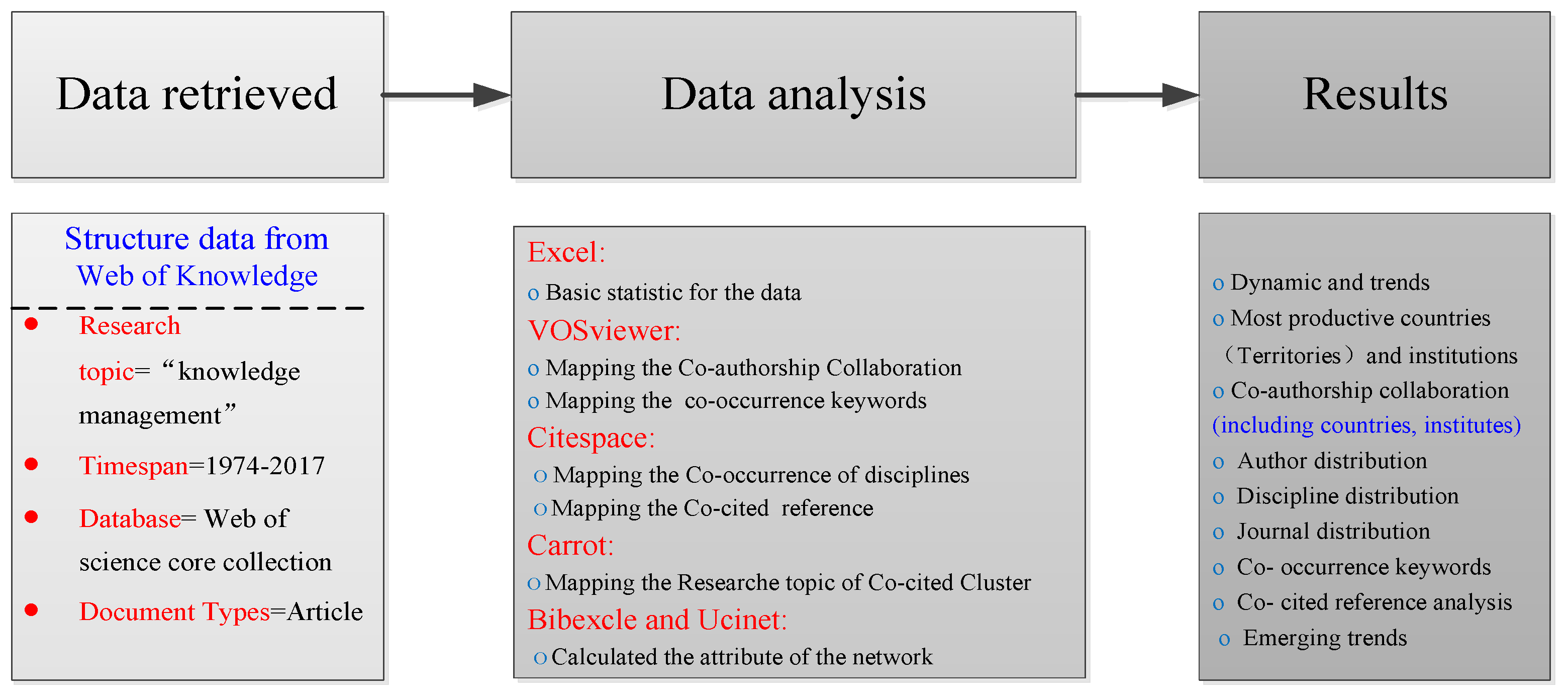
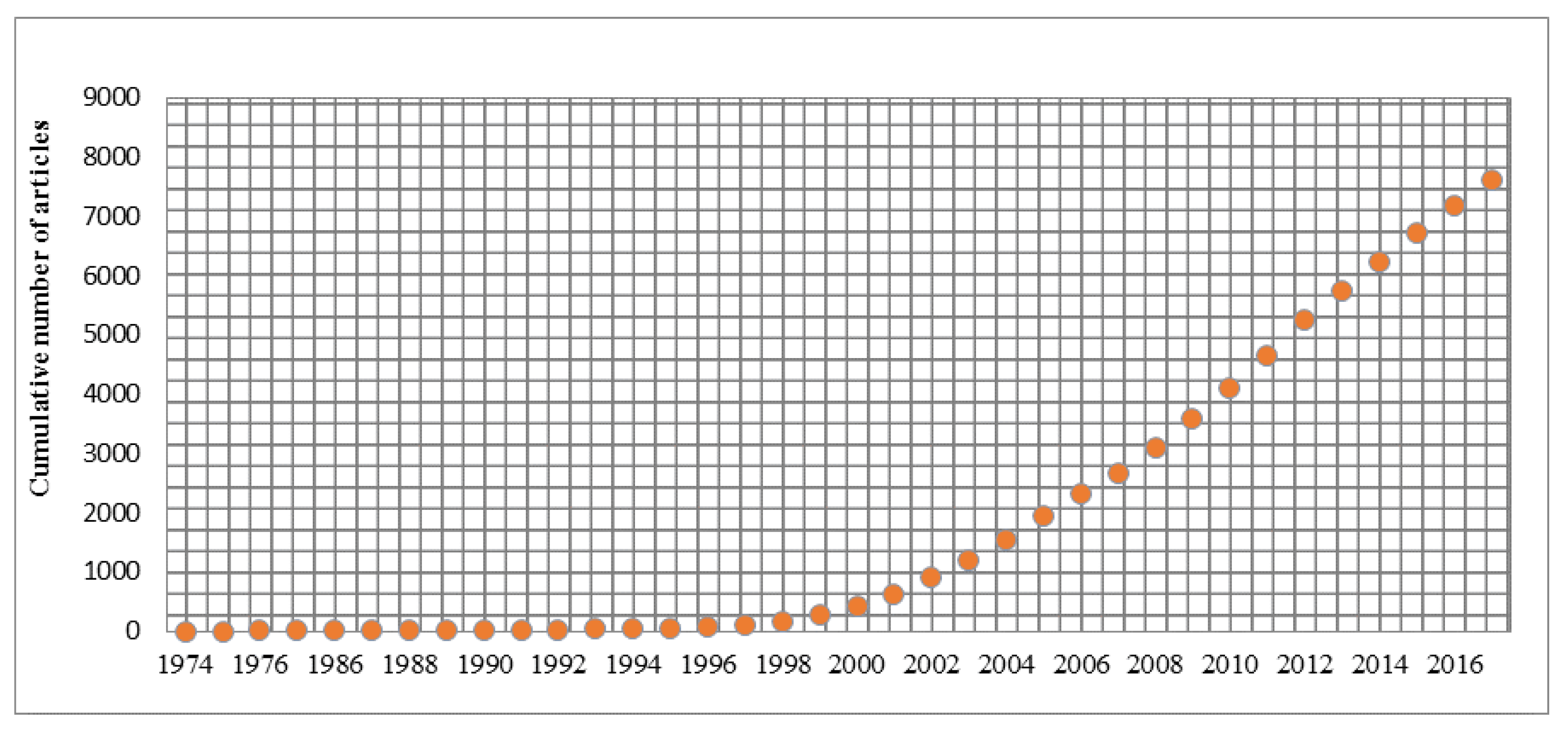
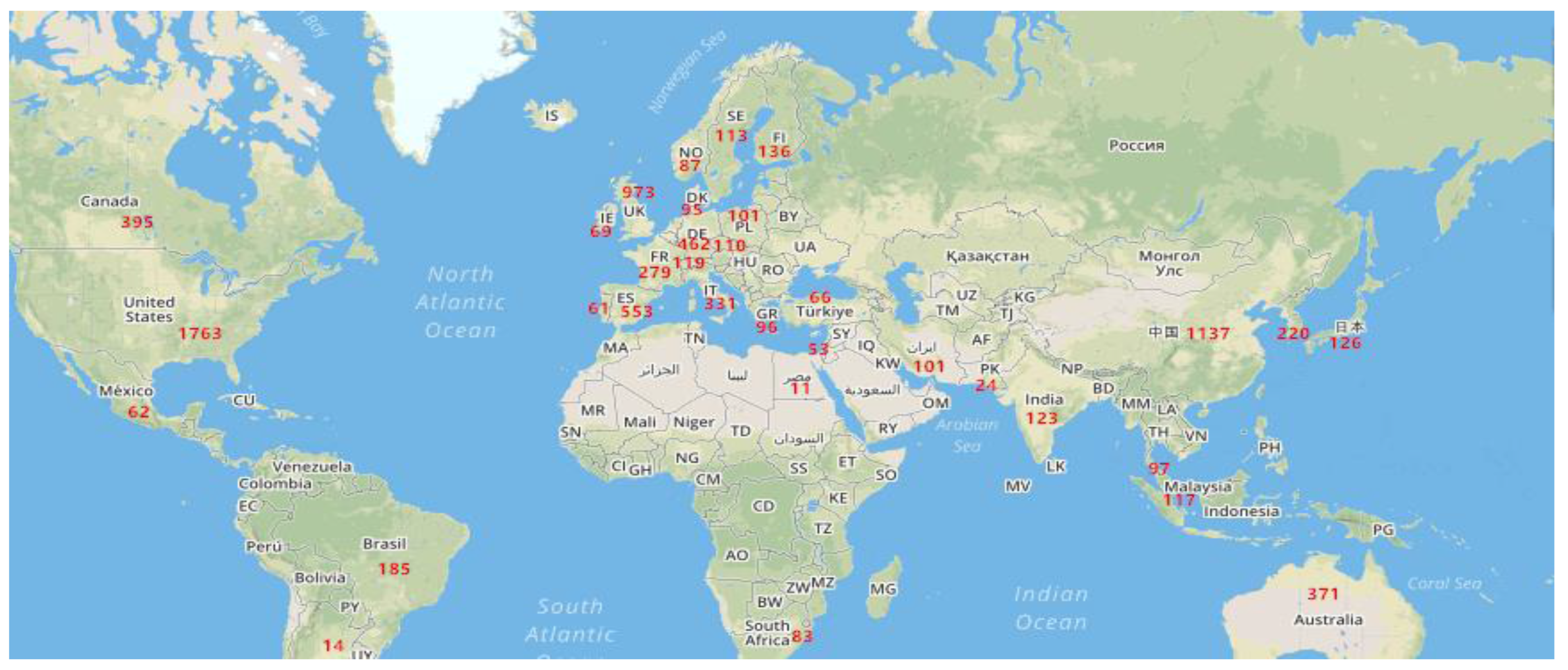
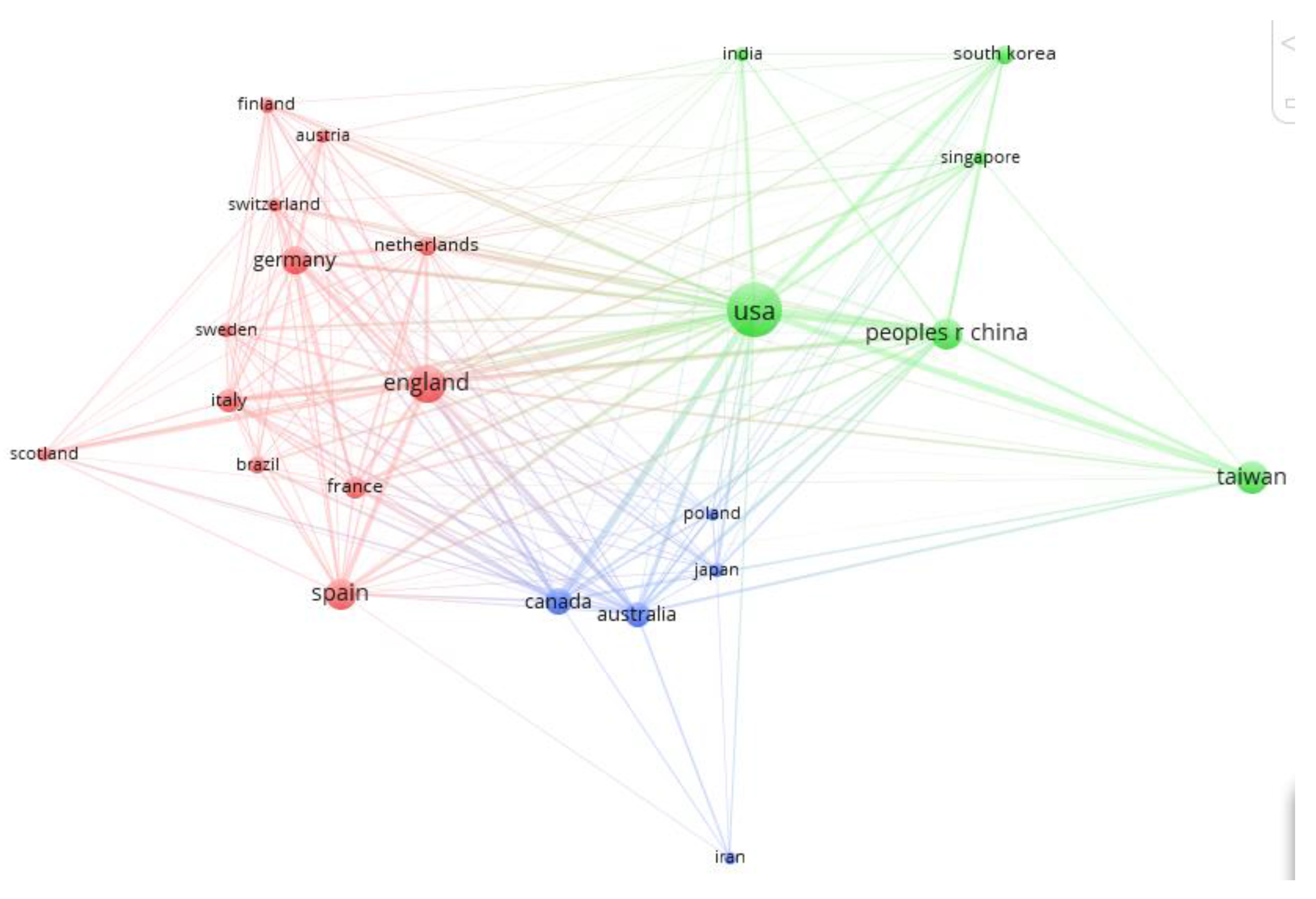
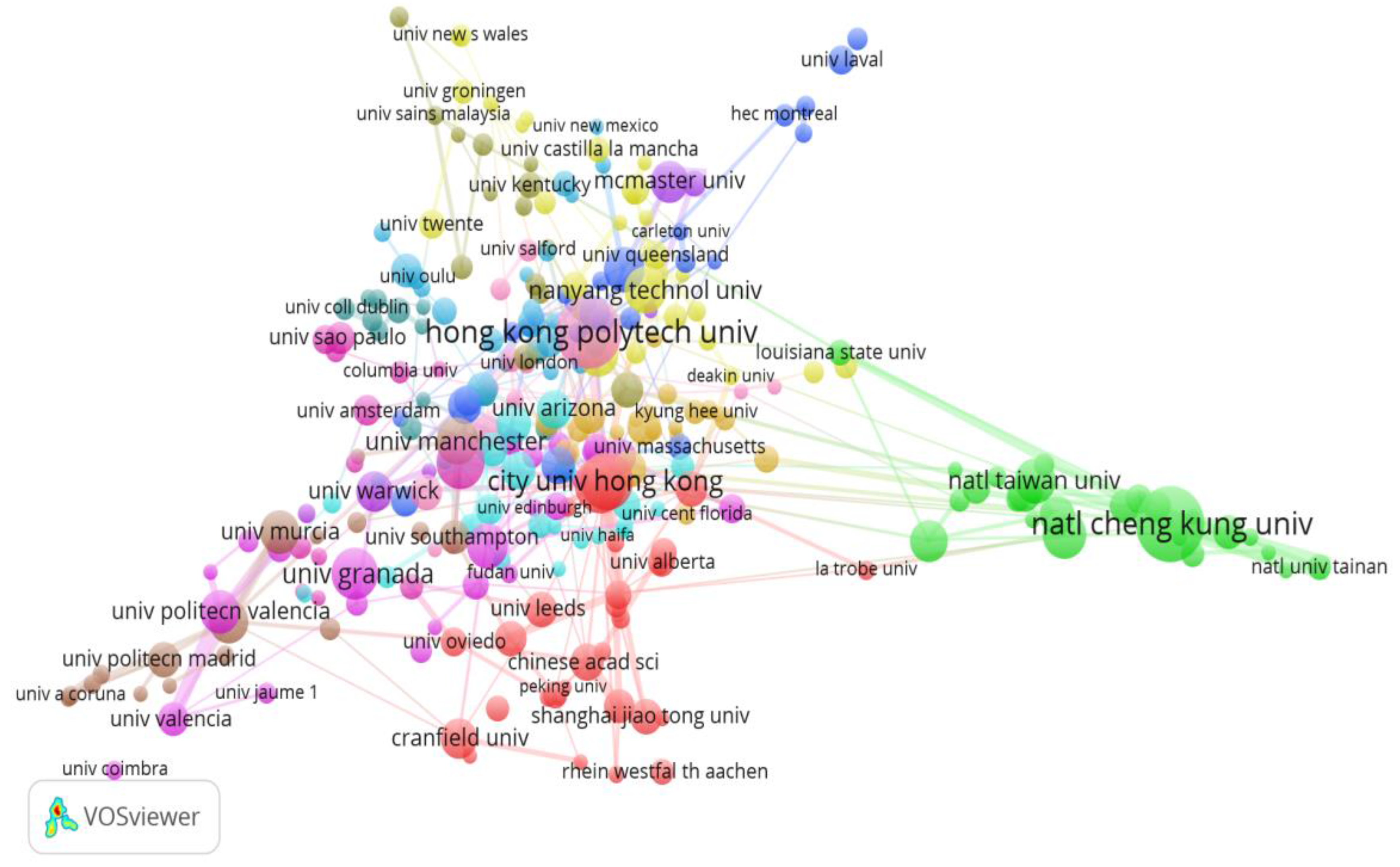
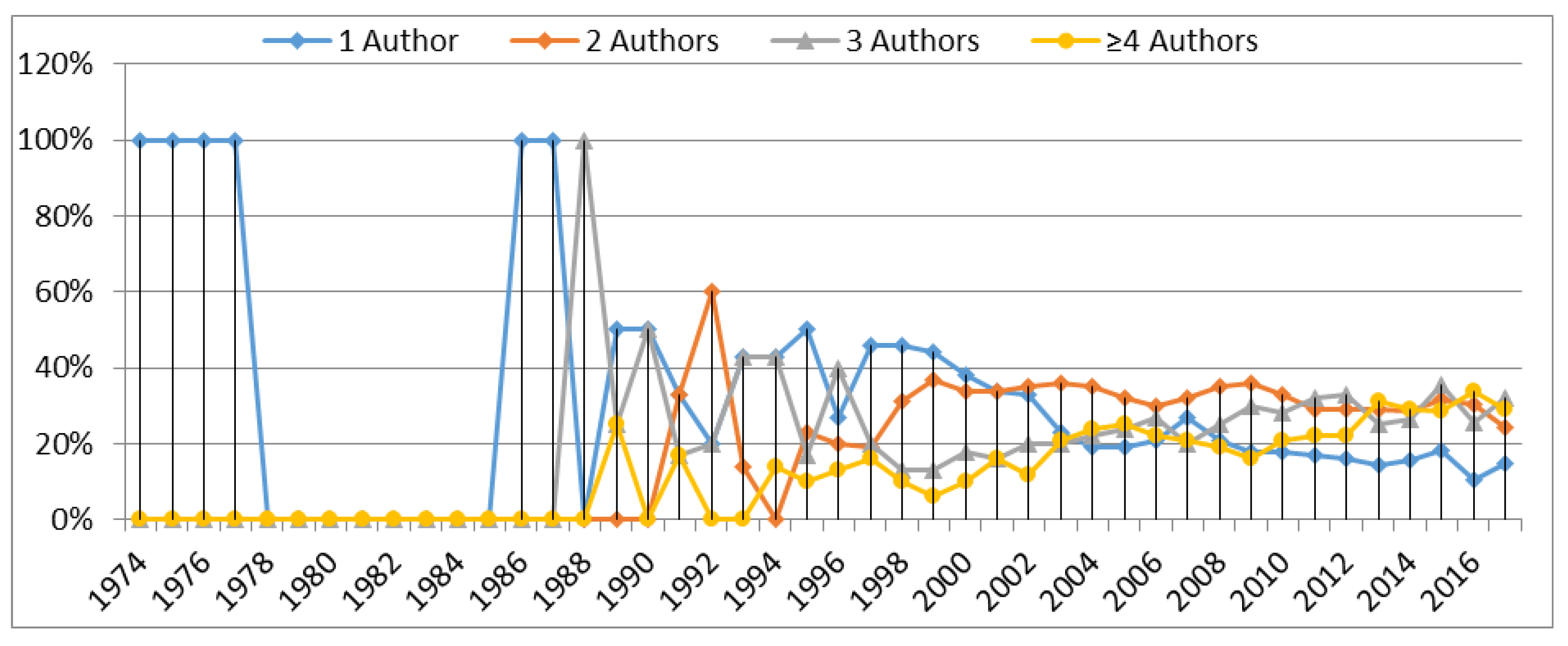
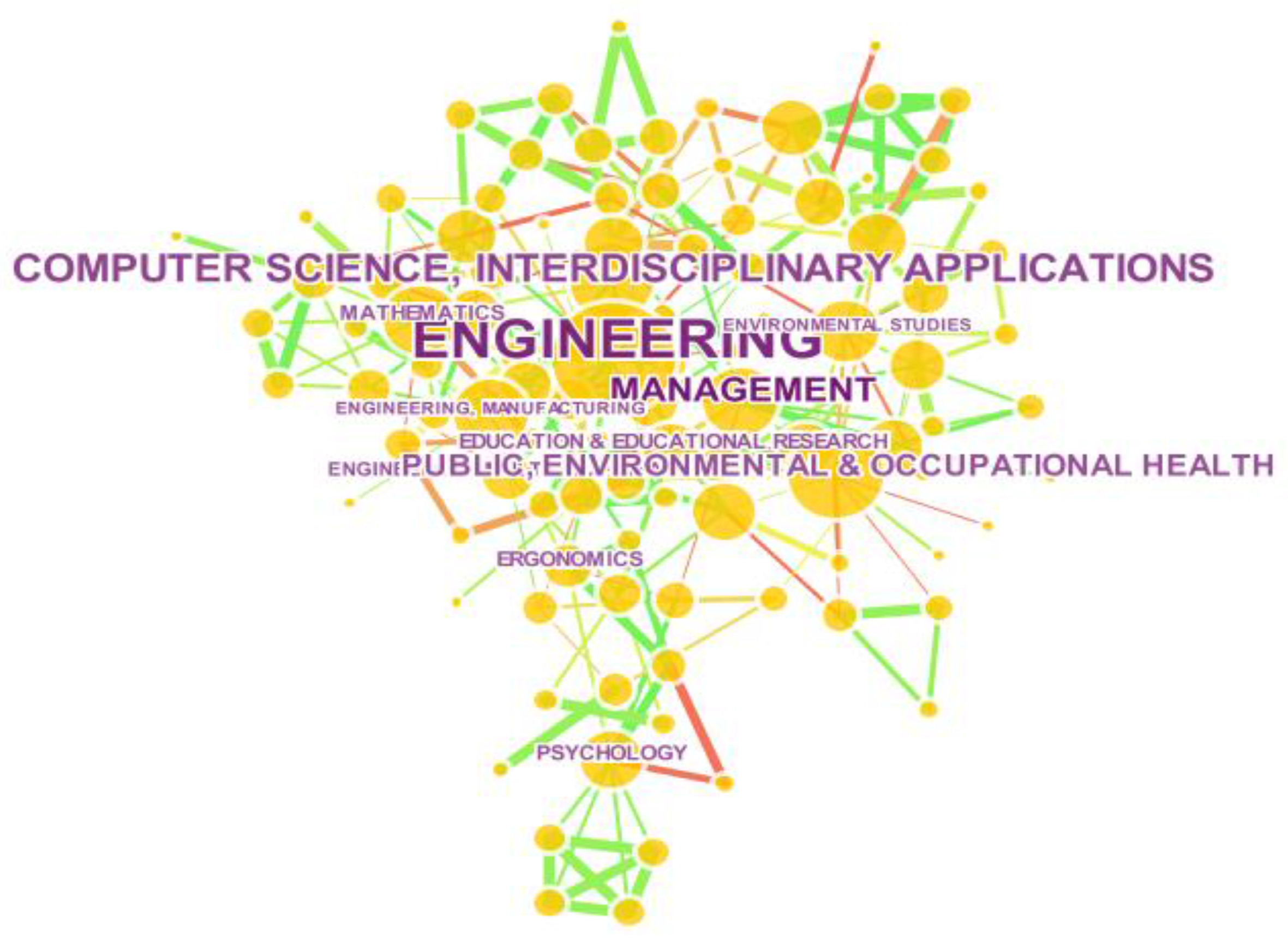
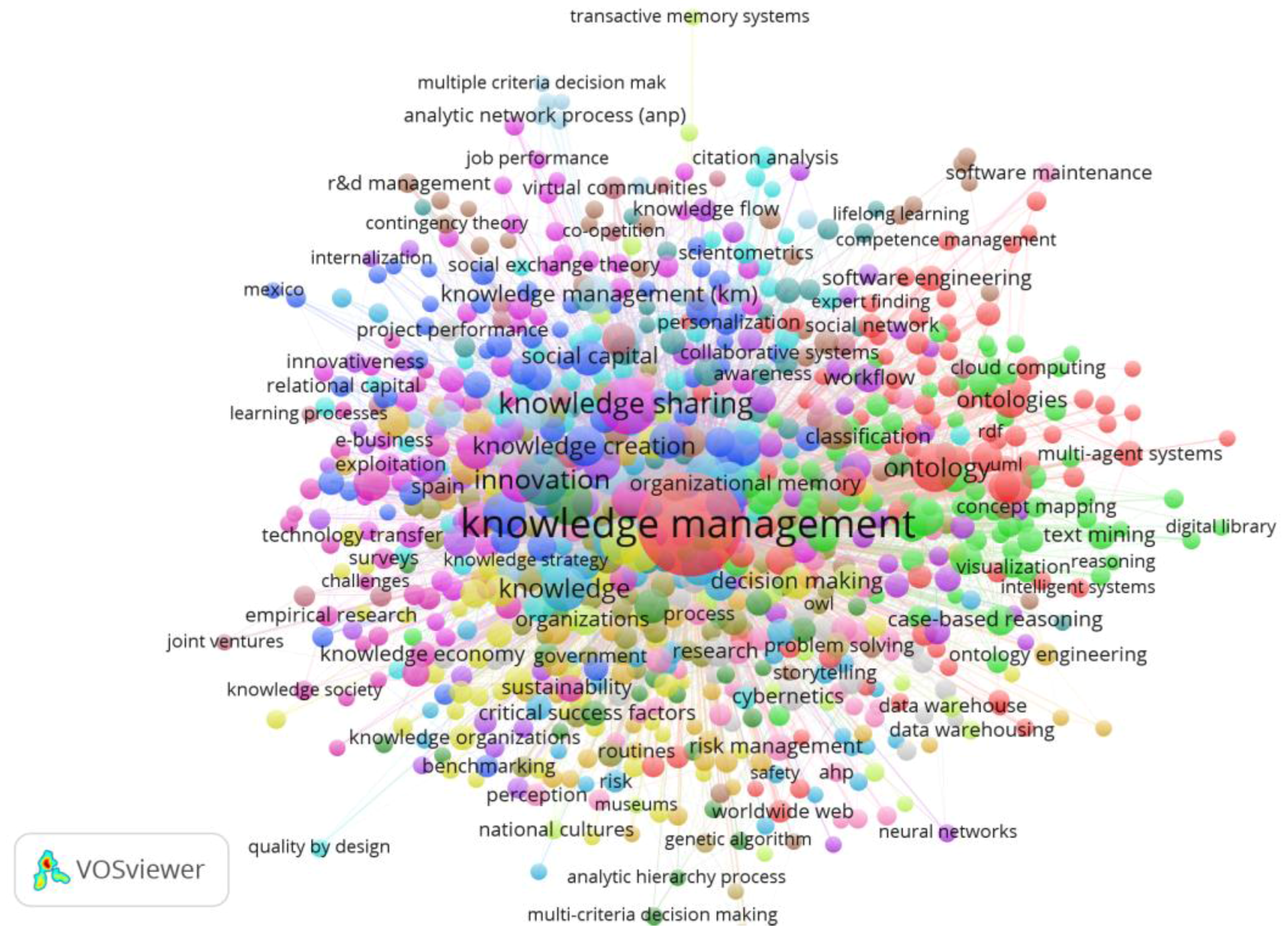
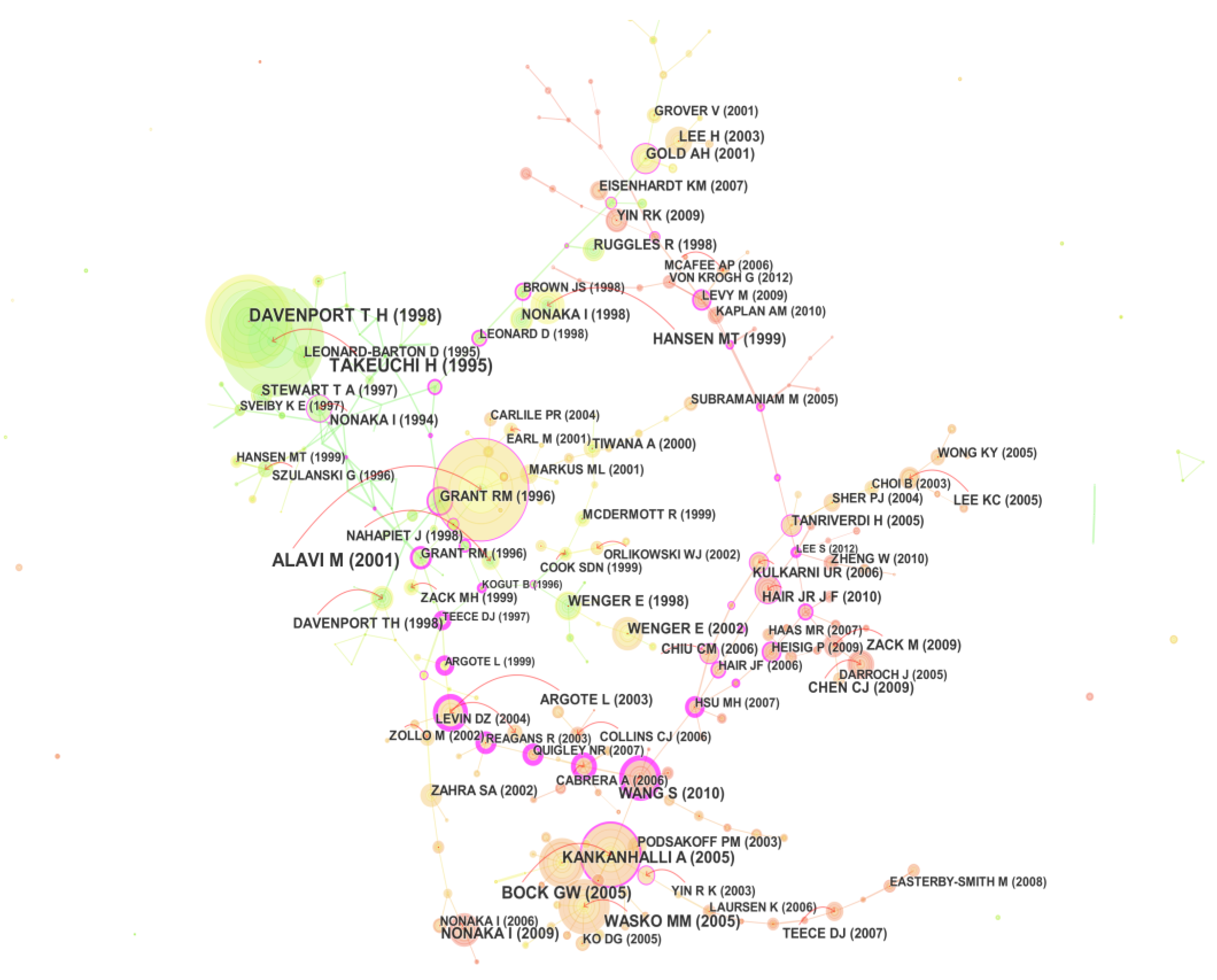
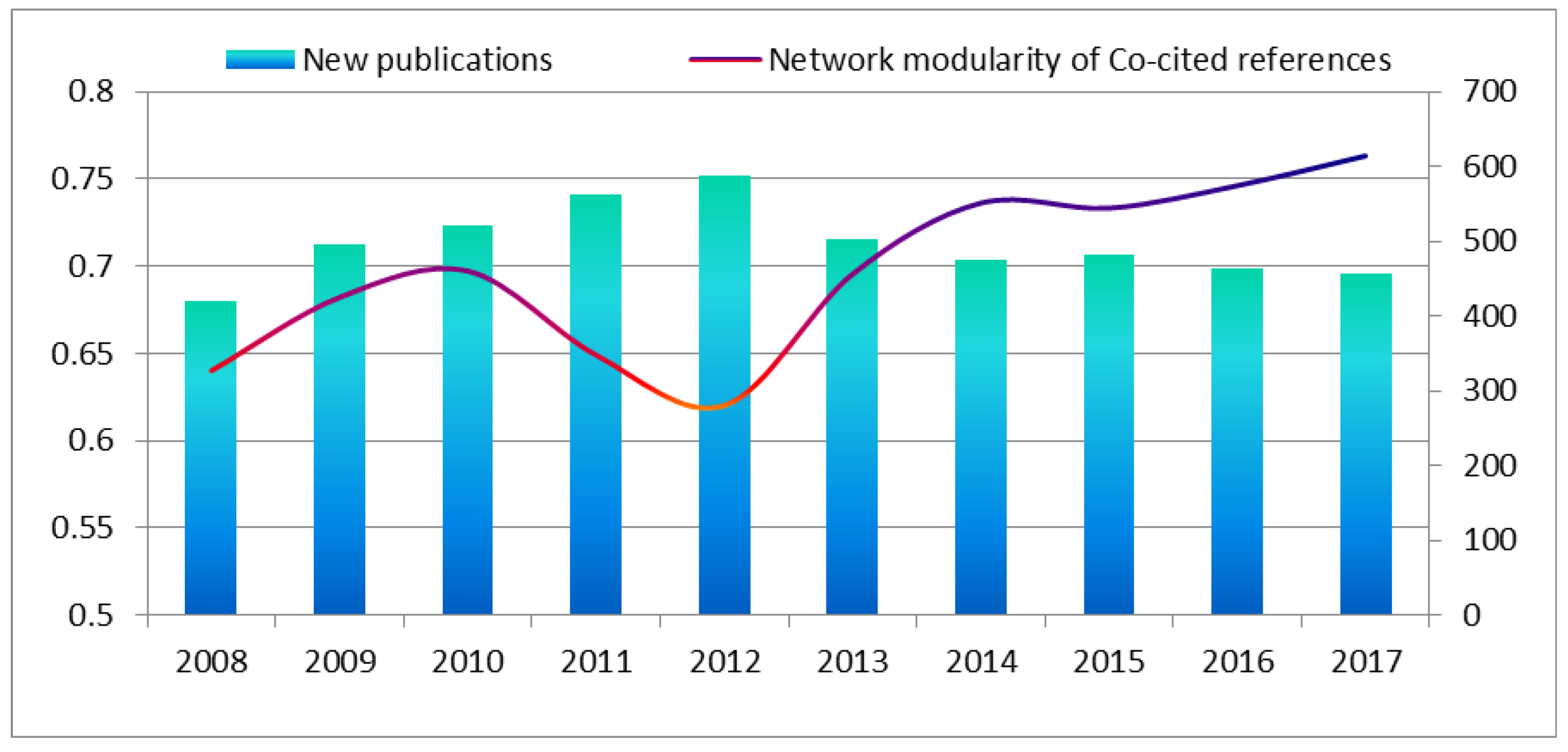
| Publication Year | NP (%) of 7628 Papers | No. Cr (TE) | AV. AU | AV. NR | AV. TC | AV. PG |
|---|---|---|---|---|---|---|
| 1974 | 1 (0.013%) | 1 | 1 | 37 | 22 | 8 |
| 1975 | 4 (0.052%) | 1 | 1 | 25 | 1.3 | 6.3 |
| 1976 | 1 (0.013%) | 1 | 1 | 48 | 4 | 13 |
| 1977 | 1 (0.013%) | 1 | 1 | 22 | 6 | 15 |
| 1986 | 2 (0.026%) | 2 | 1 | 26 | 7 | 18.5 |
| 1987 | 1 (0.013%) | 1 | 1 | 24 | 74 | 12 |
| 1988 | 1 (0.013%) | 1 | 3 | 30 | 9 | 8 |
| 1989 | 4 (0.052%) | 2 | 2 | 20.8 | 14.3 | 11.8 |
| 1990 | 2 (0.026%) | 1 | 2 | 8 | 8 | 5.5 |
| 1991 | 6 (0.079%) | 4 | 2 | 17.7 | 3.7 | 17.3 |
| 1992 | 5 (0.066%) | 5 | 1.8 | 15.4 | 1.5 | 11.2 |
| 1993 | 7 (0.092%) | 5 | 2 | 27.6 | 6.6 | 21.3 |
| 1994 | 7 (0.092%) | 7 | 2 | 20.6 | 95 | 10 |
| 1995 | 12 (0.157%) | 4 | 1.8 | 22.4 | 9.8 | 16.3 |
| 1996 | 15 (0.179%) | 7 | 2.3 | 28.2 | 99.1 | 15.7 |
| 1997 | 38 (0.498%) | 9 | 2 | 23.7 | 40.4 | 12.3 |
| 1998 | 57 (0.747%) | 17 | 2 | 23.9 | 61.4 | 13.4 |
| 1999 | 104 (1.363%) | 24 | 1.9 | 26.5 | 54.6 | 12.0 |
| 2000 | 153 (2.006%) | 28 | 2.0 | 26.7 | 40.5 | 13.5 |
| 2001 | 209 (2.740%) | 31 | 2.3 | 31.4 | 45.6 | 14 |
| 2002 | 290 (3.802%) | 40 | 2.3 | 25.3 | 30.3 | 12 |
| 2003 | 290 (3.802%) | 43 | 2.6 | 26.2 | 29.4 | 13 |
| 2004 | 330 (4.326%) | 48 | 2.8 | 28.8 | 24.5 | 12.6 |
| 2005 | 395 (5.178%) | 49 | 2.7 | 33.1 | 28.5 | 13.9 |
| 2006 | 383 (5.021%) | 57 | 2.6 | 34.8 | 26.4 | 13.7 |
| 2007 | 346 (4.536%) | 54 | 2.6 | 41.4 | 24.2 | 15.4 |
| 2008 | 420 (5.506%) | 56 | 2.6 | 43.2 | 19.6 | 14.1 |
| 2009 | 496 (6.502%) | 64 | 2.6 | 41.5 | 21.7 | 14.0 |
| 2010 | 520 (6.817%)) | 62 | 2.7 | 48.7 | 18.0 | 14.5 |
| 2011 | 562 (7.368%) | 77 | 3.0 | 51.1 | 15.6 | 15.1 |
| 2012 | 588 (7.708%) | 69 | 2.8 | 51.6 | 10.9 | 14.8 |
| 2013 | 503 (6.594%) | 70 | 3.2 | 56.4 | 10.2 | 15.4 |
| 2014 | 475 (6.227%) | 70 | 3.0 | 58.2 | 8.1 | 15.0 |
| 2015 | 481 (6.306%) | 67 | 3.2 | 61.9 | 4.8 | 16.0 |
| 2016 | 463 (6.070%) | 74 | 3.1 | 58.2 | 1.8 | 15.4 |
| 2017 | 456 (5.978%) | 67 | 3.1 | 65.6 | 0.5 | 16.4 |
| Total | 6285/100% | 123 | - | - | - | - |
| Rank | Country (Territory) | No. of Articles (%) | Citations (%) | Average | Citing Articles (%) | Institution |
|---|---|---|---|---|---|---|
| 1 | U.S. | 1763 (23.1%) | 58,283 (42.2%) | 33.06 | 17,462 (48.8) | 1624 |
| 2 | England | 837 (11 %) | 16,733 (12.1%) | 19.99 | 13,953 (18.3) | 856 |
| 3 | Taiwan | 595 (7.8%) | 10,428 (7.6%) | 17.53 | 8028 (10.5) | 233 |
| 4 | China | 579 (7.6%) | 8924 (6.5%) | 15.41 | 7461 (9.8) | 576 |
| 5 | Spain | 553 (7.3%) | 7485 (5.4%) | 13.54 | 6352 (8.3%) | 602 |
| 6 | Germany | 462 (6.1%) | 4707 (3.4%) | 10.19 | 4385 (5.8%) | 735 |
| 7 | Canada | 395 (5.2%) | 9937 (5.7%) | 20.09 | 7124 (9.3%) | 507 |
| 8 | Australia | 371 (4.9%) | 5499 (4.0%) | 14.82 | 5142 (6.7%) | 367 |
| 9 | Italy | 331 (4.3%) | 3843 (2.8%) | 11.61 | 3564 (4.7%) | 471 |
| 10 | France | 279 (3.7%) | 3758 (2.7%) | 13.47 | 3729 (4.9%) | 533 |
| 11 | Netherlands | 223 (2.9%) | 3918 (2.8%) | 17.57 | 3687 (4.8%) | 394 |
| 12 | South Korea | 220 (2.9%) | 3895 (2.8%) | 17.7 | 3394 (4.5%) | 208 |
| 13 | Brazil | 185 (2.4%) | 1190 (0.9%) | 6.43 | 1148 (1.5%) | 310 |
| 14 | Finland | 136 (1.8%) | 1819 (1.3%) | 13.38 | 1680 (2.2%) | 130 |
| 15 | Japan | 126 (1.7%) | 2540 (1.8%) | 20.16 | 2471 (3.2%) | 209 |
| 16 | India | 124 (1.6%) | 1194 (0.9%) | 9.63 | 1121 (1.5%) | 254 |
| 17 | Switzerland | 119 (1.6%) | 1906 (1.4%) | 16.02 | 1846 (2.4%) | 308 |
| 18 | Singapore | 117 (1.5%) | 3321 (2.4%) | 28.38 | 2985 (3.9%) | 159 |
| 19 | Sweden | 113 (1.5%) | 2350 (1.7%) | 20.80 | 2246 (2.9%) | 267 |
| 20 | Scotland | 111 (1.5%) | 2011 (1.5%) | 18.12 | 1936 (2.5%) | 157 |
| 21 | Austria | 110 (1.4%) | 1170 (0.8%) | 10.64 | 1161 (1.5%) | 221 |
| 22 | Iran | 102 (1.4%) | 616 (0.4%) | 6.04 | 566 (0.7%) | 91 |
| 23 | Poland | 101 (1.3%) | 638 (0.5%) | 6.32 | 610 (0.8%) | 165 |
| Country | NO.ICA | NO.ICC | DC | BC |
|---|---|---|---|---|
| USA | 596 | 77 | 22 | 11.705 |
| England | 377 | 68 | 21 | 4.339 |
| Taiwan | 99 | 24 | 14 | 0.545 |
| China | 249 | 42 | 20 | 2.695 |
| Spain | 195 | 68 | 21 | 10.032 |
| Germany | 165 | 47 | 19 | 2.311 |
| Canada | 180 | 61 | 22 | 11.705 |
| Australia | 184 | 49 | 21 | 10.973 |
| Italy | 114 | 56 | 21 | 4.339 |
| France | 122 | 51 | 19 | 2.1 |
| The Netherlands | 104 | 43 | 21 | 4.339 |
| South Korea | 67 | 26 | 14 | 1.111 |
| Brazil | 49 | 44 | 19 | 1.837 |
| Finland | 45 | 29 | 14 | 1.703 |
| Japan | 46 | 38 | 19 | 6.607 |
| India | 42 | 46 | 18 | 0.907 |
| Switzerland | 62 | 52 | 20 | 3.231 |
| Singapore | 61 | 34 | 19 | 1.889 |
| Sweden | 58 | 48 | 21 | 4.339 |
| Scotland | 50 | 30 | 12 | 0.182 |
| Austria | 47 | 34 | 18 | 2.404 |
| Iran | 29 | 13 | 5 | 0 |
| Poland | 31 | 34 | 18 | 0.907 |
| Rank | Institution | Country | Article | % of 7628 | NO.TC | AV.TC |
|---|---|---|---|---|---|---|
| 1 | National Cheng Kung University | Taiwan | 82 | 1.1% | 1419 | 17.3 |
| 2 | The Hong Kong Polytechnic University | China | 77 | 1.0% | 1542 | 20 |
| 3 | City University of Hong Kong | China | 56 | 0.7% | 2435 | 43.5 |
| 4 | National University of Singapore | Singapore | 54 | 0.7% | 2186 | 40.5 |
| 5 | University of Cambridge | England | 51 | 0.7% | 1553 | 30.5 |
| 6 | Universidad de Granada | Spain | 48 | 0.6% | 660 | 13.8 |
| 7 | National Chiao Tung University | Taiwan | 44 | 0.6% | 902 | 20.5 |
| 8 | The University of Manchester | England | 44 | 0.6% | 857 | 19.5 |
| 9 | Nanyang Technological University | Singapore | 42 | 0.6% | 518 | 12.3 |
| 10 | University of Illinois | USA | 42 | 0.6% | 2685 | 63.9 |
| 11 | National Taiwan University | Taiwan | 41 | 0.5% | 900 | 22 |
| 12 | Loughborough University | England | 41 | 0.5% | 887 | 21.6 |
| 13 | University of Toronto | Canada | 41 | 0.5% | 1737 | 42.4 |
| 14 | Polytechnic University of Valencia | Spain | 39 | 0.5% | 400 | 10.3 |
| 15 | Universidad Carlos III de Madrid | Spain | 38 | 0.5% | 1032 | 20.2 |
| 16 | University of Murcia | Spain | 38 | 0.5% | 884 | 23.3 |
| 17 | McMaster University | England | 37 | 0.5% | 936 | 25.3 |
| 18 | National Sun Yat-sen University | Taiwan | 37 | 0.5% | 1059 | 28.7 |
| 19 | Cranfield University | England | 36 | 0.5% | 800 | 22.2 |
| 20 | The University of Arizona | USA | 36 | 0.5% | 652 | 18.1 |
| 21 | University of Warwick | England | 36 | 0.5% | 917 | 25.5 |
| 22 | Harvard University | USA | 35 | 0.5% | 4263 | 121.8 |
| 23 | Indiana University | USA | 35 | 0.5% | 1353 | 38.7 |
| 24 | University of California | USA | 35 | 0.5% | 1930 | 55.1 |
| 25a | Korea Advanced Institute of Science & Technology | South Korea | 33 | 0.4% | 1654 | 50.1 |
| 25b | National Tsing Hua University | Taiwan | 33 | 0.4% | 543 | 16.5 |
| Rank | Research Institution | Degree Centrality | Research Institution | Betweenness Centrality |
|---|---|---|---|---|
| 1 | City University of Hong Kong | 44 | City University of Hong Kong | 1042.8 |
| 2 | Aalto University | 31 | National University of Singapore | 710.0 |
| 3 | Chinese Academy of Sciences | 31 | University of Cambridge | 451.0 |
| 4 | Boston College | 29 | Indiana University | 399.5 |
| 5 | Brunel University | 29 | The Hong Kong Polytechnic University | 356.3 |
| 6 | Carnegie Mellon University | 29 | Chinese Academy of Sciences | 352.0 |
| 7 | National University of Singapore | 29 | The University of Arizona | 338.7 |
| 8 | Brigham and Women's Hospital | 28 | Carnegie Mellon University | 334.4 |
| 9 | Arizona State University | 27 | Aalto University | 331.7 |
| 10 | Beihang University | 27 | University of Illinois | 331.3 |
| 11 | Boston University | 27 | Brunel University | 325.3 |
| 12 | Aston University | 26 | Arizona State University | 308.4 |
| 13 | Auburn University | 25 | Boston University | 292.1 |
| 14 | Cardiff University | 25 | Universitat de Barcelona | 289.3 |
| 15 | BI Norwegian Business School | 24 | The University of Maryland | 274.0 |
| 16 | Chang Jung Christian University | 24 | University of Oxford | 273.5 |
| 17 | Chung Hua University | 24 | Brigham and Women's Hospital | 266.0 |
| 18 | Universities in Asia | 23 | Beihang University | 218.0 |
| 19 | University of Cambridge | 23 | Penn State University | 216.0 |
| 20a | Bar Ilan University | 22 | National Cheng Kung University | 214.2 |
| 20b | Indiana University | 22 | University of Warwick | 202.3 |
| NO.AU | 1 | 1 | 1 | 2 | 2 | 1 | 2 | 5 | 7 | 5 | 11 | 15 | 19 | 26 | 41 | 41 | 125 | 328 | 14,808 |
| NO.AR | 25 | 21 | 20 | 19 | 18 | 17 | 15 | 14 | 13 | 12 | 11 | 10 | 9 | 8 | 7 | 6 | 5 | 4 | ≤3 |
| Subject Category | Records | % of Total |
|---|---|---|
| Management | 2334 | 30.6% |
| Information Science Library Science | 1723 | 22.6% |
| Computer Science Information Systems | 1349 | 17.7% |
| Computer Science Artificial Intelligence | 1050 | 13.8% |
| Operations Research Management Science | 782 | 10.2% |
| Business | 704 | 9.2% |
| Computer Science Interdisciplinary Applications | 589 | 7.7% |
| Engineering Industrial | 466 | 6.1% |
| Computer Science Theory Methods | 461 | 6.0% |
| Computer Science Software Engineering | 392 | 5.1% |
| Engineering Electrical Electronic | 361 | 4.7% |
| Engineering Manufacturing | 312 | 4.1% |
| Engineering Multidisciplinary | 305 | 4.0% |
| Engineering Civil | 168 | 2.2% |
| Education Educational Research | 160 | 2.1% |
| Computer Science Cybernetics | 154 | 2.0% |
| Economics | 151 | 2.0% |
| Medical Informatics | 151 | 2.0% |
| Health Care Sciences Services | 124 | 1.6% |
| Environmental Sciences | 109 | 1.4% |
| Social Sciences Interdisciplinary | 97 | 1.3% |
| Planning Development | 94 | 1.2% |
| Telecommunications | 93 | 1.2% |
| Public Environmental Occupational Health | 89 | 1.2% |
| Psychology Multidisciplinary | 83 | 1.1% |
| Ergonomics | 81 | 1.1% |
| Environmental Studies | 74 | 1.0% |
| Construction Building Technology | 71 | 0.9% |
| Automation Control Systems | 67 | 0.9% |
| Rank | Rank by Betweenness Centrality | Rank by Burst | ||
|---|---|---|---|---|
| Subject | Betweenness Centrality | Subject | Burst | |
| 1 | Engineering | 0.41 | Computer Science, Theory, and Methods | 84.68 |
| 2 | Computer Science, Interdisciplinary Applications | 0.31 | Computer Science, Artificial Intelligence | 78.32 |
| 3 | Management | 0.25 | Computer Science | 62.86 |
| 4 | Public, Environmental, and Occupational Health | 0.23 | Computer Science, Software Engineering | 30.63 |
| 5 | Psychology | 0.16 | Computer Science, Interdisciplinary Applications | 16.05 |
| 6 | Mathematics | 0.16 | Engineering, Multidisciplinary | 14.57 |
| 7 | Education and Educational Research | 0.16 | Science and Technology—Other Topics | 14.54 |
| 8 | Ergonomics | 0.16 | Psychology, Experimental | 13.8 |
| 9 | Engineering, Multidisciplinary | 0.14 | Computer Science, Information Systems | 12.25 |
| 10 | Engineering, Manufacturing | 0.13 | Environmental Sciences | 12.04 |
| 11 | Environmental Studies | 0.12 | Green and Sustainable Science and Technology | 11.7 |
| 12 | Psychology, Applied | 0.12 | Environmental Studies | 10.9 |
| 13 | Science & Technology - Other Topics | 0.11 | Mathematical and Computational Biology | 8.29 |
| 14 | Environmental Sciences and Ecology | 0.1 | Psychology, Multidisciplinary | 8.21 |
| 15a | Engineering, Chemical | 0.1 | Psychology | 8.17 |
| 15b | Agriculture | 0.1 | ||
| Rank | Source Title | Records | % of Total |
|---|---|---|---|
| 1 | Journal of Knowledge Management | 418 | 5.5% |
| 2 | Knowledge Management Research &Practice | 244 | 3.2% |
| 3 | Lecture Notes in Computer Science | 240 | 3.1% |
| 4 | Lecture Notes in Artificial Intelligence | 222 | 2.9% |
| 5 | Expert Systems with Applications | 198 | 2.6% |
| 6 | International Journal of Technology Management | 139 | 1.8% |
| 7 | Decision Support Systems | 109 | 1.4% |
| 8 | Journal of Universal Computer Science | 104 | 1.4% |
| 9 | International Journal of Information Management | 98 | 1.3% |
| 10 | Industrial Management Data Systems | 94 | 1.2% |
| 11 | Information Management | 64 | 0.8% |
| 12 | Knowledge Based Systems | 62 | 0.8% |
| 13 | Journal of Computer Information Systems | 61 | 0.8% |
| 14 | Journal of Information Science | 60 | 0.8% |
| 15 | Kybernetes | 59 | 0.8% |
| 16 | Journal of the American Society for Information Science and Technology | 58 | 0.8% |
| 17 | Journal of Business Research | 56 | 0.7% |
| 18 | Management Decision | 55 | 0.7% |
| 19 | Computers In Human Behavior | 54 | 0.7% |
| 20 | International Journal of Production Research | 54 | 0.7% |
| Author Keyword | Frequency | Author Keyword | Frequency |
|---|---|---|---|
| knowledge management | 3401 | case study | 83 |
| knowledge sharing | 371 | semantic web | 79 |
| innovation | 245 | data mining | 78 |
| Ontology/ontologies | 268 | knowledge acquisition | 77 |
| knowledge management systems | 178 | communities of practice | 75 |
| knowledge | 160 | collaboration | 73 |
| organizational learning | 156 | project management | 71 |
| knowledge transfer | 174 | social capital | 67 |
| intellectual capital | 121 | organizational performance | 66 |
| knowledge creation | 115 | absorptive capacity | 64 |
| tacit knowledge | 98 | performance | 63 |
| information management | 95 | competitive advantage | 58 |
| information technology | 94 | management | 57 |
| information systems | 93 | new product development | 56 |
| organization culture | 87 | Web 2.0 | 56 |
| learning | 83 | trust |
| Keyword | Degree Centrality | Keyword | Betweenness Centrality |
|---|---|---|---|
| knowledge management | 804 | knowledge management | 409,205.3 |
| knowledge sharing | 323 | knowledge sharing | 33,225.5 |
| innovation | 248 | innovation | 17,793.34 |
| knowledge transfer | 194 | ontology | 10,521.03 |
| organizational learning | 185 | knowledge transfer | 10,416.32 |
| knowledge | 184 | organizational learning | 8946.413 |
| ontology | 176 | knowledge | 8879.887 |
| knowledge creation | 158 | knowledge management systems | 6898.824 |
| knowledge management systems | 155 | knowledge creation | 6300.001 |
| learning | 148 | learning | 5458.257 |
| information systems | 136 | information systems | 5039.425 |
| tacit knowledge | 134 | tacit knowledge | 4859.399 |
| collaboration | 127 | information management | 4369.465 |
| information management | 122 | collaboration | 4126.945 |
| information technology | 119 | information technology | 3869.026 |
| intellectual capital | 118 | intellectual capital | 3704.719 |
| knowledge acquisition | 114 | knowledge management (km) | 3635.064 |
| performance | 106 | semantic web | 3409.226 |
| semantic web | 104 | knowledge acquisition | 3283.395 |
| communities of practice | 102 | communities of practice | 2992.594 |
| social capital | 100 | performance | 2686.415 |
| management | 98 | project management | 2570.325 |
| project management | 96 | data mining | 2569.916 |
| case study | 95 | management | 2496.138 |
| organizational culture | 95 | social capital | 2375.459 |
| data mining | 89 | case study | 2216.155 |
| absorptive capacity | 88 | new product development | 2071.063 |
| new product development | 87 | organizational culture | 1976.951 |
| knowledge management (km) | 86 | internet | 1751.147 |
| competitive advantage | 83 | absorptive capacity | 1730.339 |
| Rank | Citation Counts | First Author | Journal (Book) | Year |
|---|---|---|---|---|
| 1 | 231 | Nonaka | Oxford University Press | 1995 |
| 2 | 212 | Alavi | MIS Quarterly | 2001 |
| 3 | 199 | Davenport | Harvard Business School Press | 1998 |
| 4 | 133 | Bock | MIS Quarterly | 2005 |
| 5 | 118 | Wasko | MIS Quarterly | 2005 |
| 6 | 109 | Kankanhalli | MIS Quarterly | 2005 |
| 7 | 80 | Hansen | Harvard Business Review | 1999 |
| 8 | 77 | Wang | Human Resource Management Review | 2010 |
| 9 | 77 | Nonaka | Organization Science | 2009 |
| 10 | 76 | Wenger | Harvard Business School Press | 2002 |
| 11 | 70 | Wenger | Systems Thinker | 1998 |
| 12 | 67 | Gold | Journal of Management Information Systems | 2001 |
| 13 | 66 | Lee | Journal of Management Information Systems | 2003 |
| 14 | 65 | Chen | Journal of Business Research | 2009 |
| 15a | 63 | Argote | Management Science | 2003 |
| 15b | 63 | Hair | Prentice-Hall | 2010 |
| ID | Size | Silhouette | Label (TF*IDF) | Label (LLR) | Label (MI) | Mean Year |
|---|---|---|---|---|---|---|
| 0 | 26 | 0.961 | profitability | Asia; call center; case study; modularity; dynamic capability | knowledge acquisition; knowledge creation; knowledge sharing; knowledge transfer; barriers and facilitator | 2009 |
| 1 | 20 | 0.974 | profitability | knowledge management system; new product development; organizational knowledge management; corporate strategy; product development | quality; knowledge management system; dimension; customer orientation; information system | 2000 |
| 2 | 20 | 0.991 | social constructionist analysis; pseudo-knowledge sharing | technology mediated learning; knowledge sharing; identity; gender; enjoyment | service quality; strategy; model; satisfaction; performance; success | 2004 |
| 3 | 18 | 0.961 | empirical analysis | boundary spanning; ERP system; ERP usage; key user; information technology professional | innovation; thinking; managing knowledge; systems thinking; information | 2011 |
| 4 | 18 | 0.975 | information sharing; work groups | human resource management; innovation; ultra-peripheral region; manufacturing performance; knowledge management | human capital; human resource management; innovation; start up; human resource management | 2007 |
| 5 | 18 | 0.936 | business format; concept | knowledge organization; product development; creation theory; management; community | dynamic capability; process alignment; organizational learning culture; competitive advantage; information technology | 2001 |
| 6 | 18 | 0.93 | knowledge management tutorial; people | knowledge management; cognitive congruence; schema; relationship script; resource-based view | resource based view; competitive advantage; firm; epistemology; creativity | 1999 |
| 7 | 18 | 0.93 | knowledge management; knowledge assets | organizational impact of knowledge-based system; knowledge engineering; core competency; job quality; knowledge-based system | intellectual capital measurement; knowledge management; intangible assert cognition | 1995 |
| 8 | 18 | 0.835 | information technology management; successful knowledge management projects | strategic alliance; knowledge transfer; causal ambiguity; organizational learning; knowledge management | resource based view; competitive advantage; firm; epistemology; creativity | 1995 |
| 9 | 17 | 0.919 | biotechnology sector | transitive memory system; team performance; field study; group decision making; coordinating expertise | human capital; human resource management; innovation; start up; corporate | 2002 |
| 10 | 15 | 0.8 | information technology management; information technology | Socio technical system; organizational memory; firm; appropriation problem; technological change | management of technology; technological learning; knowledge management; knowledge transfer; strategy | 1994 |
| 11 | 15 | 0.894 | impact; innovation | information sharing/withholding; knowledge transfer; reference group; profession; science | knowledge market; dyadic knowledge; knowledge management; knowledge exchange; intangible knowledge | 2000 |
| 12 | 14 | 0.953 | social media research; influence | knowledge based view; information system; social software; open innovation; managing knowledge | knowledge acquisition; knowledge creation; knowledge sharing; knowledge transfer; barriers and facilitator | 2010 |
| 13 | 13 | 0.954 | fundamental issue; antecedents | information technology; organizational performance; business performance; competitive advantage; research proposition | dynamic capability; process alignment; organizational learning culture; competitive advantage; information technology | 2005 |
| 14 | 10 | 0.949 | learning processes; firm level perspective | organizational change; product development; model; transformation; technology | social interaction; organization; innovation performance; manufacturing firm | 2006 |
| Cluster Details | Cited Articles (ranked by citations) | |||
|---|---|---|---|---|
 | Frequency | First Author | Year | Title |
| 65 | Chen | 2009 | Strategic human resource practices and innovation performance: the mediating role of knowledge management capacity | |
| 63 | Hair | 2010 | Multivariate data analysis: A global perspective | |
| 55 | Zack | 2009 | Knowledge management and organizational performance: an exploratory analysis | |
| 43 | Heisig | 2009 | Harmonisation of knowledge management—comparing 160 KM frameworks around the globe | |
| 40 | Zheng | 2010 | Linking organizational culture, structure, strategy, and organizational effectiveness: Mediating role of knowledge management | |
| 38 | Hair | 2006 | Multivariate data analysis: A global perspective | |
| 36 | Haas | 2007 | Different knowledge, different benefits: Toward a productivity perspective on knowledge sharing in organizations. | |
| 36 | Hsu | 2007 | Knowledge sharing behavior in virtual communities: The relationship between trust, self-efficacy, and outcome expectations | |
| 35 | Darroch | 2005 | Knowledge management, innovation and firm performance | |
| 33 | He | 2009 | A comparison of purchase decision calculus between potential and repeat customers of an online store | |
| Cluster Details | Cited articles (ranked by number of citations) | |||
|---|---|---|---|---|
 | Frequency | First Author | Year | Title |
| 80 | Hansen | 1999 | What’s your strategy for managing knowledge? | |
| 67 | Gold | 2001 | Knowledge Management: An Organizational Capabilities Perspective | |
| 66 | Lee | 2003 | Market Process Reengineering through Electronic Market Systems: Opportunities and Challenges | |
| 61 | Nonaka | 1998 | The concept of ‘Ba’: building a foundation for knowledge creation. | |
| 57 | Ruggles | 1998 | The state of the notion: knowledge management in practice | |
| 43 | Lee | 2001 | Exploring mediation between environmental and structural attributes: the penetration of communication technologies in manufacturing organizations | |
| 37 | Brown | 1998 | Organizing Knowledge | |
| 31 | Liao | 2003 | Knowledge management technologies and applications-literature review from 1995 to 2002 | |
| 30 | Dell | 1998 | If Only We Knew What We Know: Identification and Transfer of Internal Best Practices | |
| 29 | Becerra-Fernandez | 2001 | Organizational Knowledge Management: A Contingency Perspective | |
| Cluster Details | Cited Articles (Ranked by Number of Citations) | |||
|---|---|---|---|---|
 | Frequency | First Author | Year | Title |
| 133 | Bock | 2005 | Behavioral intention formation in knowledge sharing: examining the roles of extrinsic motivators, social-psychological factors, and organizational climate | |
| 118 | Wasko | 2005 | Why should I share? Examining social capital and knowledge contribution in electronic net- works of practice | |
| 109 | KankanHalli | 2005 | Contributing knowledge to electronic knowledge repositories: an empirical investigation | |
| 50 | Podsakoff | 2003 | Common method biases in behavioral research: A critical review of the literature and recommended remedies | |
| 44 | Ko | 2005 | Antecedents of Knowledge Transfer from Consultants to Clients in Enterprise System Implementations | |
| 34 | Lin | 2007 | A stage model of knowledge management: An empirical investigation of process and effectiveness | |
| 32 | Garud | 2005 | Vicious and Virtuous Circles in the Management of Knowledge: The Case of Infosys Technologies | |
| 29 | Ardichvili | 2003 | Motivation and barriers to participation in virtual knowledge-sharing communities of practice | |
| 28 | Alavi | 2005 | An Empirical Examination of the Influence of Organizational Culture on Knowledge Management Practices | |
| 28 | Delone | 2003 | Information System Success: A Ten Years Update | |
| Centrality | First Author | Year | Source | Cluster ID |
|---|---|---|---|---|
| 0.91 | Wang | 2010 | Human Resource Management Review | 4 |
| 0.89 | Teece | 1997 | Strategic Management Journal | 11 |
| 0.84 | Cabrera | 2006 | The International Journal of Human Resource Management | 4 |
| 0.81 | Argote | 2003 | Management Science | 11 |
| 0.81 | Reagans | 2003 | Administrative Science Quarterly | 11 |
| 0.81 | Argote | 1999 | Springer, Berlin | 11 |
| 0.8 | Quigley | 2007 | Organization Science | 11 |
| 0.67 | Hsu | 2007 | International Journal of Human-Computer Studies | 0 |
| 0.48 | Grant | 1996 | Organization Science | 11 |
| 0.41 | Lee | 2012 | Journal of Knowledge Management | 0 |
| Strength | Reference | Burst Start Year | Burst End Year |
|---|---|---|---|
| 106.699 | Spender, J.C.; 1996, Strategic Management Journal | 1996 | 2003 |
| 78.583 | Grant, R.M.; 1996, Strategic Management Journal | 2005 | 2009 |
| 70.1433 | Nonaka, I.; 1995, Oxford University Press | 1999 | 2006 |
| 30.9065 | Alavi, M.; 2001, MIS Quart | 2010 | 2013 |
| 29.37 | Davenport, T.H.; 1998, Harvard Business School Press | 2013 | 2017 |
| 29.1145 | Bock, G.W.; 2005, MIS Quart | 2005 | 2002 |
| 26.2479 | Wang, S.; 2010, Human Resource Management Review | 2010 | 2013 |
| 25.7965 | Nonaka, I.; 1994, Organization Science | 2009 | 2013 |
| 25.3509 | Wasko, M.M.; 2005, MIS Quart, | 2005 | 2007 |
| 24.9287 | Kankanhalli, A.; 2005, MIS Quart | 2013 | 2017 |
| 24.7793 | Hansen, M.T.; 1999, Harvard Business Review | 2000 | 2006 |
| 23.7432 | Hair, J.F., Jr.; 2010, Prentice-Hall | 2010 | 2003 |
| 22.1144 | Wenger, E.; 1998, Cambridge University Press | 1998 | 2005 |
| 22.0813 | Leonard-Barton, D.; 1995, Harvard Business School Press | 2000 | 2006 |
| 21.9779 | Stewart, T.A.; 1997, Crown Business | 1997 | 2004 |
| Reference | Citations | Title | Source | Burst | Duration |
|---|---|---|---|---|---|
| Krogh | 35 | How does social software change knowledge management? Toward a strategic research agenda | Journal of Strategic Information Systems | 15.8391 | 2014–2017 |
| Andreeva | 32 | Does knowledge management really matter? Linking knowledge management practices competitiveness and economic performance | Journal of Knowledge Management | 14.9919 | 2014–2017 |
| Durst | 30 | Knowledge management in SMEs: a literature review | Journal of Knowledge Management | 13.963 | 2014–2017 |
| Chen | 21 | Business intelligence and analytics: from big data to big impact | MIS Quarterly | 10.0375 | 2014–2017 |
| Zhou | 18 | How knowledge affects radical innovation: Knowledge base, market knowledge acquisition, and internal knowledge sharing | Strategic Management Journal | 8.4999 | 2014–2017 |
| Guthire | 14 | Reflections and projections: A decade of Intellectual Capital Accounting Research | British Accounting Review | 7.8466 | 2015–2017 |
| Lee | 18 | An integrated view of knowledge management for performance | Journal of Knowledge Management | 7.8046 | 2014–2017 |
| McAfee | 12 | Big data: the management revolution. | Harvard Business Review | 6.7234 | 2015–2017 |
| Podsakoff | 14 | Sources of method bias in social science research and recommendations on how to control it. | Annual Review of Psychology | 6.457 | 2015–2017 |
| Chan | 11 | An empirical investigation of factors affecting e-collaboration diffusion in SMEs | International Journal of Production Economics | 5.6126 | 2014–2017 |
© 2018 by the authors. Licensee MDPI, Basel, Switzerland. This article is an open access article distributed under the terms and conditions of the Creative Commons Attribution (CC BY) license (http://creativecommons.org/licenses/by/4.0/)
Share and Cite
Wang, P.; Zhu, F.-W.; Song, H.-Y.; Hou, J.-H.; Zhang, J.-L. Visualizing the Academic Discipline of Knowledge Management. Sustainability 2018, 10, 682. https://doi.org/10.3390/su10030682
Wang P, Zhu F-W, Song H-Y, Hou J-H, Zhang J-L. Visualizing the Academic Discipline of Knowledge Management. Sustainability. 2018; 10(3):682. https://doi.org/10.3390/su10030682
Chicago/Turabian StyleWang, Peng, Fang-Wei Zhu, Hao-Yang Song, Jian-Hua Hou, and Jin-Lan Zhang. 2018. "Visualizing the Academic Discipline of Knowledge Management" Sustainability 10, no. 3: 682. https://doi.org/10.3390/su10030682
APA StyleWang, P., Zhu, F.-W., Song, H.-Y., Hou, J.-H., & Zhang, J.-L. (2018). Visualizing the Academic Discipline of Knowledge Management. Sustainability, 10(3), 682. https://doi.org/10.3390/su10030682





